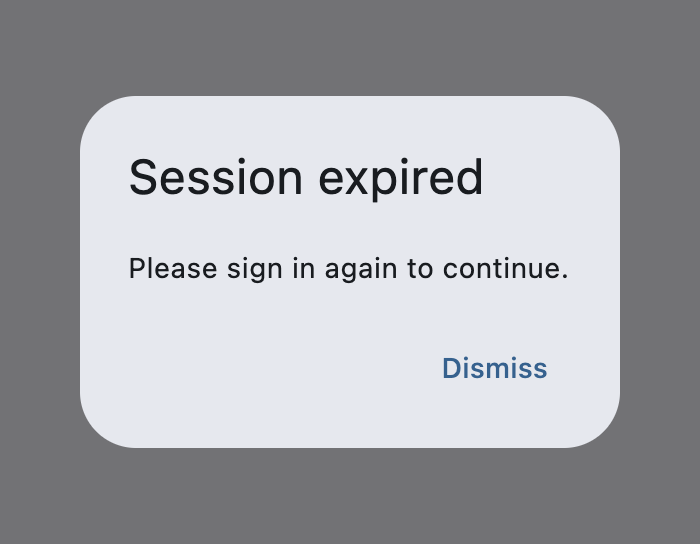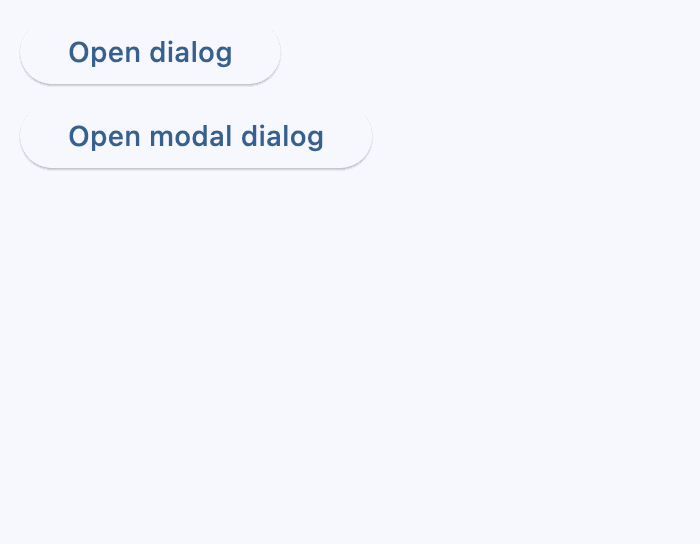AlertDialog
Basic AlertDialog
Inherits: DialogControl
Properties
-
action_button_padding(PaddingValue | None) –The padding that surrounds each button in
actions. -
actions(list[Control]) –A set of actions that are displayed at the bottom of this dialog.
-
actions_alignment(MainAxisAlignment | None) –Defines the horizontal layout of the actions.
-
actions_overflow_button_spacing(Number | None) –The spacing between
actionswhen theOverflowBar -
actions_padding(PaddingValue | None) –Padding around the set of
actionsat the bottom of this dialog. -
alignment(Alignment | None) –How to align this dialog.
-
barrier_color(ColorValue | None) –The color of the modal barrier that
-
bgcolor(ColorValue | None) –The background color of this dialog's surface.
-
clip_behavior(ClipBehavior) –Defines how the contents of this dialog are clipped (or not)
-
content(Control | None) –The content of this dialog is displayed in the center of this dialog in a
-
content_padding(PaddingValue | None) –Padding around the
content. -
content_text_style(TextStyle | None) –The style for the text in the
contentof this dialog. -
elevation(Number | None) –Defines the elevation (z-coordinate) at which this dialog should appear.
-
icon(Control | None) –A control that is displayed at the top of this dialog.
-
icon_color(ColorValue | None) –The color for the Icon in the
iconof this dialog. -
icon_padding(PaddingValue | None) –Padding around the
icon. -
inset_padding(PaddingValue | None) –Padding around this dialog itself.
-
modal(bool) –Whether dialog can be dismissed/closed by clicking the area outside of it.
-
scrollable(bool) –Determines whether the
titleand -
semantics_label(str | None) –The semantic label of this dialog used by accessibility frameworks to announce
-
shadow_color(ColorValue | None) –The color used to paint a drop shadow
-
shape(OutlinedBorder | None) –The shape of this dialog.
-
title(StrOrControl | None) –The title of this dialog is displayed in a large font at its top.
-
title_padding(PaddingValue | None) –Padding around the
title. -
title_text_style(TextStyle | None) –TBD
Examples#
Modal and non-modal dialogs#
import flet as ft
def main(page: ft.Page):
page.title = "AlertDialog examples"
dialog = ft.AlertDialog(
title=ft.Text("Hello"),
content=ft.Text("You are notified!"),
alignment=ft.Alignment.CENTER,
on_dismiss=lambda e: print("Dialog dismissed!"),
title_padding=ft.Padding.all(25),
)
modal_dialog = ft.AlertDialog(
modal=True,
title=ft.Text("Please confirm"),
content=ft.Text("Do you really want to delete all those files?"),
actions=[
ft.TextButton("Yes", on_click=lambda e: page.pop_dialog()),
ft.TextButton("No", on_click=lambda e: page.pop_dialog()),
],
actions_alignment=ft.MainAxisAlignment.END,
on_dismiss=lambda e: print("Modal dialog dismissed!"),
)
page.add(
ft.Button(
content="Open dialog",
on_click=lambda e: page.show_dialog(dialog),
),
ft.Button(
content="Open modal dialog",
on_click=lambda e: page.show_dialog(modal_dialog),
),
)
if __name__ == "__main__":
ft.run(main)
Modal and non-modal dialogs
Properties#
class-attribute
instance-attribute
#
action_button_padding: PaddingValue | None = None
The padding that surrounds each button in actions.
class-attribute
instance-attribute
#
A set of actions that are displayed at the bottom of this dialog.
Typically this is a list of TextButton controls.
Raises:
class-attribute
instance-attribute
#
actions_alignment: MainAxisAlignment | None = None
Defines the horizontal layout of the actions.
Internally defaults to MainAxisAlignment.END.
class-attribute
instance-attribute
#
actions_overflow_button_spacing: Number | None = None
The spacing between actions when the OverflowBar
switches to a column layout because the actions don't fit horizontally.
If the controls in actions do not fit into a single row, they are arranged into a
column. This parameter provides additional vertical space between buttons when it
does overflow.
class-attribute
instance-attribute
#
actions_padding: PaddingValue | None = None
Padding around the set of actions at the bottom of this dialog.
Typically used to provide padding to the button bar between the button bar and the edges of this dialog.
If are no actions, then no padding will be included. The padding around the button bar defaults to zero.
class-attribute
instance-attribute
#
alignment: Alignment | None = None
How to align this dialog.
If None, then DialogTheme.alignment is used.
If that is also None, the default is Alignment.CENTER.
class-attribute
instance-attribute
#
barrier_color: ColorValue | None = None
The color of the modal barrier that darkens everything below this dialog.
If None, then DialogTheme.barrier_color is used.
If that is also None, the default is Colors.BLACK_54.
class-attribute
instance-attribute
#
bgcolor: ColorValue | None = None
The background color of this dialog's surface.
class-attribute
instance-attribute
#
clip_behavior: ClipBehavior = NONE
Defines how the contents of this dialog are clipped (or not)
to the given shape.
class-attribute
instance-attribute
#
content_padding: PaddingValue | None = None
Padding around the content.
If there is no content, no padding will be provided. Otherwise, padding of 20
pixels is provided above the content to separate the content from
the title, and padding of 24 pixels is provided on the left, right,
and bottom to separate the content from the other edges of this dialog.
class-attribute
instance-attribute
#
content_text_style: TextStyle | None = None
The style for the text in the content of this dialog.
If None, DialogTheme.content_text_style is used.
If that's is also None, defaults to
TextTheme.body_medium (if Theme.use_material3 is True;
TextTheme.title_medium otherwise) of
Theme.text_theme.
class-attribute
instance-attribute
#
elevation: Number | None = None
Defines the elevation (z-coordinate) at which this dialog should appear.
class-attribute
instance-attribute
#
icon: Control | None = None
A control that is displayed at the top of this dialog.
Typically a Icon control.
class-attribute
instance-attribute
#
icon_color: ColorValue | None = None
The color for the Icon in the icon of this dialog.
If None, DialogTheme.icon_color is used.
If that is null, defaults to color scheme's ColorScheme.secondary if
Theme.use_material3 is True, Colors.BLACK otherwise.
class-attribute
instance-attribute
#
icon_padding: PaddingValue | None = None
Padding around the icon.
class-attribute
instance-attribute
#
inset_padding: PaddingValue | None = None
Padding around this dialog itself.
Defaults to Padding.symmetric(vertical=40, horizontal=24) - 40 pixels
horizontally and 24 pixels vertically outside of this dialog box.
class-attribute
instance-attribute
#
modal: bool = False
Whether dialog can be dismissed/closed by clicking the area outside of it.
class-attribute
instance-attribute
#
semantics_label: str | None = None
The semantic label of this dialog used by accessibility frameworks to announce screen transitions when this dialog is opened and closed.
On iOS, if this label is not provided, a semantic label will be inferred from the
title if it is not None.
class-attribute
instance-attribute
#
shadow_color: ColorValue | None = None
The color used to paint a drop shadow
under this dialog, which reflects this dialog's elevation.
class-attribute
instance-attribute
#
shape: OutlinedBorder | None = None
The shape of this dialog.
If None, defaults to DialogTheme.shape.
If it is also None, it defaults to RoundedRectangleBorder(radius=4.0).
class-attribute
instance-attribute
#
title: StrOrControl | None = None
The title of this dialog is displayed in a large font at its top.
Typically a Text control.
class-attribute
instance-attribute
#
title_padding: PaddingValue | None = None
Padding around the title.
If there is no title, no padding will be provided. Otherwise, this padding is used.
Defaults to 24 pixels on the top, left, and right of the title.
If the content is not None, then no bottom padding
is provided (see content_padding).
If it is not set, then an extra 20 pixels of bottom padding is added to separate
the title from the actions.

